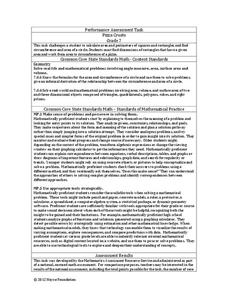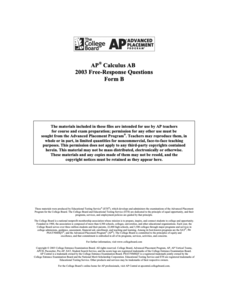EngageNY
Estimating Probabilities by Collecting Data
Take a spin to determine experimental probability. Small groups spin a spinner and keep track of the sums of the spins and calculate the resulting probabilities. Pupils use simulated frequencies to practice finding other probabilities to...
Noyce Foundation
Pizza Crusts
Enough stuffed crust to go around. Pupils calculate the area and perimeter of a variety of pizza shapes, including rectangular and circular. Individuals design rectangular pizzas with a given area to maximize the amount of crust and do...
Houston Area Calculus Teachers
Cubic Polynomial
Birthdays are a time for celebration, and now they're a time for calculation! An AP calculus lesson uniquely explores relationships between a polynomial function and its derivative. Learners create a cubic function based...
National Institute of Open Schooling
Chemical Arithmetics
Substances with the same empirical and molecular formula must be differentiated by their structural formula. Part two in a series of 36 has pupils using chemical formulas to calculate how much of a compound is present in a given...
Noyce Foundation
Which is Bigger?
To take the longest path, go around—or was that go over? Class members measure scale drawings of a cylindrical vase to find the height and diameter. They calculate the actual height and circumference and determine which is larger.
West Contra Costa Unified School District
Interest and the Number “e”
Make a connection between different types of interest and how they are calculated! This algebra II lesson progresses from simple interest to compound interest to continually compounded interest. Formulas are developed rather than given,...
National Institute of Open Schooling
Chemical Equilibrium
Le Chatelier's interest in thermodynamics and building materials such as cement and plaster led to the Le Chatelier Principle in 1884. Activity 13 in a series of 36 extensively explores chemical equilibrium. Learners read about...
College Board
2005 AP® Calculus AB Free-Response Questions
Develop an awareness of the exam. Pupils and teachers use the six release free-response questions to see how the exam covers topics. The questions are divided among calculator and non-calculator items. Scholars see the importance of...
College Board
2000 AP® Calculus BC Free-Response Questions
How are concepts divided? Pupils use the AP® Calculus free-response questions to see how the exam addresses concepts. The concepts are divided into those that use calculators and others that do not. Calculator items require finding...
College Board
2006 AP® Calculus AB Free-Response Questions Form B
An exam divides the six free-response questions into calculator use and no calculator use items. The non-calculator items are conceptual in nature and test whether pupils understand the calculus concepts. Scholars explain their answers...
CK-12 Foundation
Tangent Line Approximation: Estimating Square Roots
Estimating a square root is as easy as evaluating a linear equation. Using the derivative of the square root function, pupils calculate an estimation of square roots. Class members determine the equation of the tangent line at the value...
EngageNY
Polynomial, Rational, and Radical Relationships
This assessment pair goes way beyond simple graphing, factoring and solving polynomial equations, really forcing learners to investigate the math ideas behind the calculations. Short and to-the-point questions build on one another,...
College Board
2004 AP® Calculus BC Free-Response Questions
Given a set of questions, pupils realize the way the Calculus BC free-response exam asks questions. The items include both contextual and non-contextual questions. Both types are split into the calculator and non-calculator sections for...
College Board
2012 AP® Calculus BC Free-Response Questions
Get better prepared. Individuals use the six released AP® Calculus BC free-response questions to practice for the actual exam. The questions contain two calculator items and four non-calculator items. Topics include particle movement,...
College Board
2007 AP® Calculus AB Free-Response Questions Form B
What do the questions look like? Six free-response questions provide pupils with knowledge of how calculus topics appear on the AP® Calculus exam. The questions involve calculator and non-calculator problems by providing mathematical and...
College Board
2004 AP® Calculus BC Free-Response Questions Form B
Take another look at the exam. A set of questions is a different form for the 2004 AP® Calculus BC free-response question section. The questions are evenly split into calculator and non-calculator sections. Pupils use their knowledge of...
Flipped Math
Calculus AB/BC - Approximating a Function's Value Using Local Linearity
No need to be exact every time. Pupils watch an engaging video on approximating function values. They see how to write the equation of a tangent line, use it to calculate approximations, and then determine whether it is an overestimate...
College Board
2008 AP® Calculus BC Free-Response Questions
The AP® exam is not just about the calculations. By reviewing the free-response questions from 2008, teachers and pupils see that several items require justifications and explanations to gain full credit. The chief reader even points out...
College Board
2003 AP® Calculus AB Free-Response Questions Form B
Get a better grasp of the intended content. The six free-response questions provide insight into the purpose of the AP® Calculus content. Two questions have real-world context while the remaining are void of context. The items range from...
College Board
2011 AP® Calculus BC Free-Response Questions
Does the exam look pupils expected? Released free-response questions from the AP® Calculus BC exam allow teachers and pupils to see and practice with actual exam questions. Three of the questions come from the AB portion of the course...
College Board
2010 AP® Calculus AB Free-Response Questions Form B
Most say that practice makes perfect. Scholars use the released free-response questions to practice for the AP® Calculus AB exam. Each question comes with several parts and either do or do not allow calculators. Items include topics such...
College Board
2011 AP® Calculus AB Free-Response Questions Form B
Half are real-world. The 2011 AP® Calculus AB free-response questions let pupils and teachers see how content appears on the exam. Half of the questions contain real-world context, and four items do not allow calculators. Real-world...
EngageNY
Calculating Conditional Probabilities and Evaluating Independence Using Two-Way Tables (part 2)
Without data, all you are is another person with an opinion. Show learners the power of statistics and probability in making conclusions and predictions. Using two-way frequency tables, learners determine independence by analyzing...
EngageNY
Using Tree Diagrams to Represent a Sample Space and to Calculate Probabilities
Cultivate the tree of knowledge using diagrams with two stages. Pupils create small tree diagrams to determine the sample space in compound probability problems. The instructional activity uses only two decision points to introduce tree...























